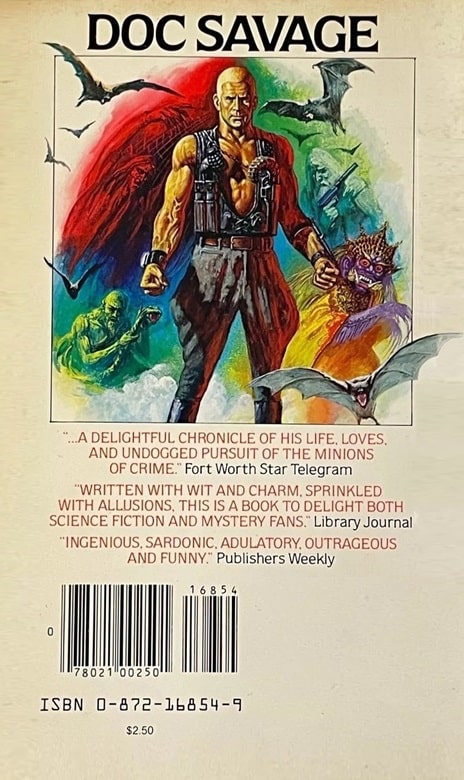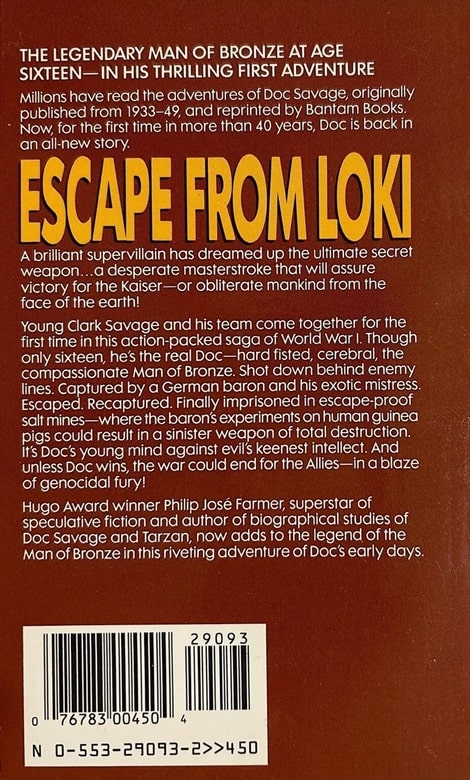Tarzan and Beyond: Philip Jose Farmer, Part II
 |
 |
Tarzan Alive and Doc Savage: His Apocalyptic Life (Playboy
Paperbacks, August 1981 and July 1981). Covers: uncredited, Ken Barr
Read the first half of this article, The World of Tiers and Beyond: Philip Jose Farmer, Part I.
Continuing our examination of Farmer’s pastiches, Farmer soon gave up the Grandrith and Caliban names and went full on with the characters in two fictional biographies called Tarzan Alive (1972) and Doc Savage: His Apocalyptic Life (1973), both from Playboy’s Science Fiction line.
The cover for Tarzan Alive is very cool but is uncredited. Ken Barr seems to have done the Doc Savage cover and it’s also very cool. I liked both of these books pretty well. The Tarzan book rambles a bit. The Doc Savage is better than many of the original Doc Savage novels. It references quite a few. These books are true to the characters and have none of the bizarre sexual exploits described in A Feast Unknown.
These books also suggest that Tarzan, Doc Savage, and such other fictional characters as Sherlock Holmes are all related to each other and are the product of inherited mutations caused by a meteor that struck England in 1795 called either the Wold Cottage or the Wold Newton Meteor.
 |
 |
Back covers for Tarzan Alive and Doc Savage: His Apocalyptic Life
Some of the other “Wold-Newton relatives” of Tarzan and Savage are Robert E. Howard’s Solomon Kane, and such literary characters as Captain Blood, The Scarlet Pimpernel, Nero Wolf, Travis McGee, Sam Spade, and the pulp heroes The Shadow and The Spider. Interestingly, other writers have played in the Wold-Newton world of Farmer. Would this be considered pastiches of a pastiche?
Farmer also wrote a pastiche novel where Holmes meets Tarzan, though I haven’t read it. It was published in 1974 and called The Adventure of the Peerless Peer. The story was supposedly told by Dr. John Watson.
 |
 |
Escape from Loki (Bantam Falcon, August 1991). Cover by Steve Assel
The last pastiche novel I read from Farmer was Escape from Loki, from Bantam Falcon, with a cover by Steve Assel. This was a pretty decent Doc Savage adventure, featuring a very young Doc, who was only about 16 in the novel.
After my PJF marathon I decided to take it easy. What follows is mostly just pics and capsule reviews of other Farmer books I’ve read.
1. Image of the Beast, published by Playboy Press, 1979, cover by Enric. Also contains the connected book Blown, which was also published separately. Farmer’s pornographic sendup of private eye stories. It was endlessly inventive but a little much for me, honestly. I didn’t find it erotic. I enjoy sex scenes that serve the book but not so much when the book serves the sex scenes.
2. Flesh. Signet, 1969. Cool cover by Bob Pepper. Another of Farmer’s sex romps, inventive, although not as explicit as Image of the Beast. An earth space explorer named “Stagg” returns to earth after 800 years to be worshiped as a virility god by huge numbers of willing women. It didn’t do a lot for me.
3. The Stone God Awakens. Ace Books, 1970. Cover by Josh Kirby, although not one of his best. The book features another of Farmer’s Native American heroes — Ulysses Singing Bear, but he wasn’t as interesting as Kickaha or Two Hawks. This is actually my least favorite PJF book, although I probably would have loved it as a teenager. One annoying thing is that it doesn’t have chapters. It’s just one continuing narrative. I also know there are plenty of people who love it, though. It offers an early view of the Uplift phenomenon, in which animals evolve into sentient, humanoid like species.
4. Tongues of the Moon. Pyramid Books, 1964. Cover artist uncredited. Certainly starts out with a bang, with colonies on Mars and the Moon witnessing the destruction of Earth. One of Farmer’s earliest books. OK, but not outstanding.
5. Dare. Berkley, 1965, with a fine cover by Greg Theakston. What happened to the lost Roanoke Colony? Farmer gives an answer here. They got transported to another world where now they dwell side by side with an alien race they call “horsetails.” This was an entertaining work although it feels almost unfinished at times, or hurried perhaps. It’s the only one of this bunch that has a Sword & Planet vibe.
6. Jesus on Mars, Pinnacle Books, 1979, cover by Paul Stinson. I liked this one quite a bit. It seemed to me to be a bit of a riff off Heinlein’s Stranger in a Strange Land, but I thought this one was better. Farmer was just endlessly inventive.
Charles Gramlich administers The Swords & Planet League group on Facebook, where this post first appeared. His last article for Black Gate was Part I of his look at the fantasy novels of Philip Jose Farmer.

I read part of The Stone God Awakens back when it was newly published, and a few months ago I managed to identify the title and author from what I remembered of it. I hadn’t gotten far enough to see the uplift plot; I thought the cat-girl was the result of the evolution of a second sapient species through natural processes. In fact I had the impression that she was descended from New World monkeys, or perhaps from squirrels; if I had gotten to the part when she was identified as feline it didn’t sink in. Rereading it now, I thought it was ironic that Farmer gave us an early version of the beautiful cat-girl (though not as early as E.E. Smith’s Vesta) but never had the attraction consummated (I mean, this is Philip José Farmer we’re talking about). I thought the story overall had a very pulp flavor.
This might have been early on when Farmer was a little more controlled about the sexual aspects of his writing. Or maybe the editors had their way and cut some stuff out. It is interesting though, considering the very clear sexual aspects of so much of his writing.
Probably not, because ISFdb says it came out in 1970. “Mother” dates back to 1953, and “Open to Me, My Sister” to 1960. So he was already well established as an explicit writer.
I’m surprised, by the way, to see so late a date; I thought I started to read it in the early to mid 1960s. I wonder if I’m misremembering, or if I’m confusing it with some other work of a similar description (man from the present wakes up in a remote future and becomes attached to a beautiful female of a different humanoid species)?
By 1970, though, we had already seen not only Vesta, but [Cordwainer] Smith’s C’mell and Leiber’s Tigerishka.
interesting mystery
You may also enjoy an early PJF standalone, The Green Odyssey, which I recall reading with great enjoyment.
I’ve heard of it but not read it
I enjoyed the Green Odyssey immensely. Probably my favorite PJF
cool